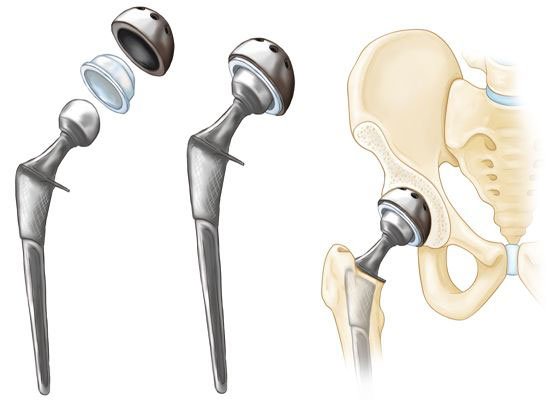- 1st floor, 28 Shiv Shakti Nagar, near Indo Bharat School, Nirman Nagar, Jaipur, Rajasthan 302019
- +91 9001740688
- Mon - Sat: 4:00PM - 7:00PM

Total Hip Replacement Surgery
The hip joint is a type of ball and socket joint that gives stability to the body needed to bear body weight while allowing mobility.
The hip joint is articulated between the head of the femur and the acetabulum of the pelvis. The acetabulum is a cup-like depression covered by the articular cartilage. The cavity of the acetabulum is deepened by the acetabular labrum which is a fibrocartilaginous collar. The head of the femur is a hemispherical structure that articulates with the acetabulum of the pelvis. The articular capsule of the hip joint is attached to the margin of the acetabulum proximally and is strong and dense.
Ligaments of the hip joint
The ligaments of the hip joint increase stability and are of two types intracapsular and extracapsular. The intracapsular ligament is relatively small and runs from the acetabular fossa to the fovea of the femur. The Intracapsular ligament is innervated by a branch of the obturator artery. The Extracapsular ligament constitutes 3 main structures which lie in continuous with the outer surface of the articular capsule. Iliofemoral ligament is a “Y” shaped structure that helps prevent hyperextension of the hip joint.

The pubofemoral ligament runs through the capsule anteriorly and inferiorly and prevents excessive abduction and extension. The Ischiofemoral ligament reinforces the capsule posteriorly and prevents hyperextension of the hip while holding the femoral head in the acetabulum.
Neurovascular supply
The hip joint is innervated with Medial and lateral circumflex femoral arteries which anastomoses at the base of the femoral neck to form a ring. Three nerves called Sciatic, femoral and obturator nerves innervate the hip joint and also the knee. This is the reason why pain can be experienced in the knee from the hip and vice versa.
Common causes of Hip Pain:
- Degenerative diseases like arthritis, osteoarthritis, and rheumatoid arthritis that cause stiffness, reduced range of motion, and pain which usually gets worse with time.
- Hip fractures may result due to weakened bones or accident and trauma.
- Bursitis is an inflammatory condition of the Bursae which are fluid-filled sacs found between the tissues such as bone, muscles, and tendons. Bursitis can cause pain and irritate the hip joint.
- Tendinitis is the inflammation of the tendons due to repetitive stress from overuse can cause hip pain.
- Wear and tear of the muscle or tendon due to overuse, can cause pain and prevent the hip from working normally.
- A hip labral tear is a tear in the ring of cartilage that acts like a rubber seal to help hold the ball at the top of your thighbone safely within your hip socket.
- Avascular necrosis is a condition that occurs when blood flow to the hip bone slows down causing the tissue to die. This condition is not so common but can worsen hip pain.
When do you need a Total Hip Replacement Surgery?
Total hip replacement surgery is recommended in a condition where an individual experience:
- Continuous pain that persists even after taking medication
- Pain that worsens with walking, even from using a cane or walker
- Insomnia due to pain
- Damaged hip joint due wear and tear causing pain.
- Inability to climb up and down the stairs.
The procedure followed in total Hip Replacement Surgery
Total Hip Replacement surgery takes only a few hours. During the surgery your orthopedic surgeon:
- Makes an incision through the layers of tissue, on the front or side of your hip.
- After which, the surgeon removes the diseased and damaged parts of bone and cartilage and replace them with implants leaving healthy bone intact.
- An artificial Prosthetic socket is implanted into the pelvic bone, after replacing the damaged socket and the round ball is replaced with a prosthetic ball along with a stem that fits into the thigh bone.
Over time the techniques for hip replacement are constantly updated and nowadays orthopedic surgeons are using less invasive and computer-assisted techniques to reduce the recovery time and pain due to total hip replacement surgery.
How successful is Total Hip Replacement Surgery?
The success rate of total hip replacement surgery is extremely high. It is the most performed surgery and more than 90% and patients undergoing this surgery experience relief and improved quality of life from hip pain. In case of implant wear and aseptic loosening, a patient can also undergo revision hip replacement surgery.

Emergency Cases
+91 9001740688Opening Hours
- Saturday - Saturday: 4:00 PM - 7.00 PM
- Sunday: Will Be Closed
